2018 Hyundai Ioniq Electric ECO mode
[x] Cancel search: ECO modePage 481 of 541
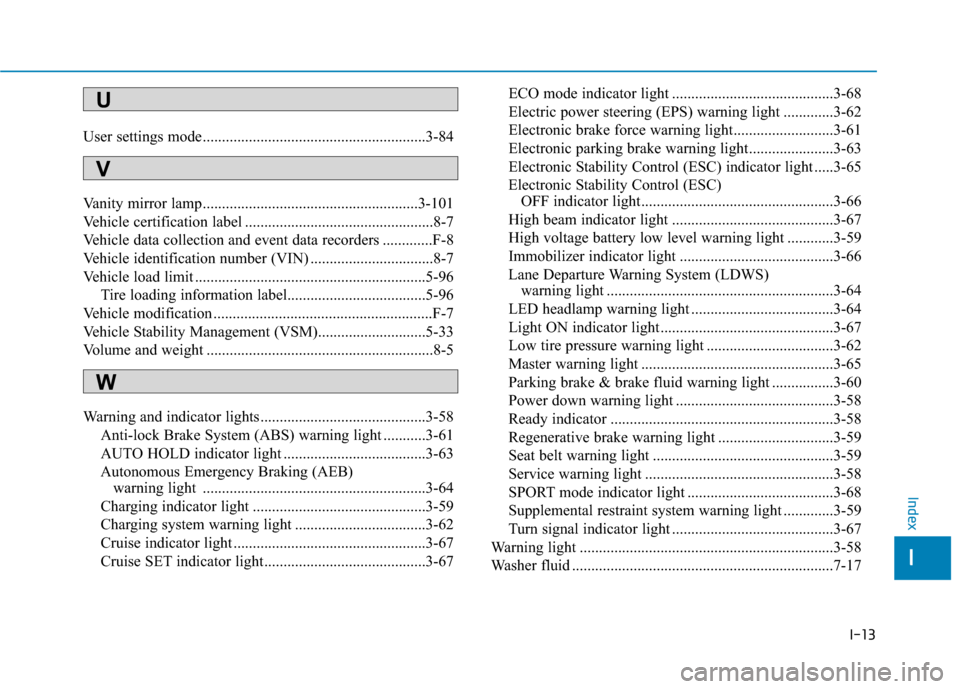
I-13
User settings mode..........................................................3-84
Vanity mirror lamp........................................................3-101
Vehicle certification label .................................................8-7
Vehicle data collection and event data recorders .............F-8
Vehicle identification number (VIN) ................................8-7
Vehicle load limit ............................................................5-96Tire loading information label....................................5-96
Vehicle modification .........................................................F-7
Vehicle Stability Management (VSM)............................5-33
Volume and weight ...........................................................8-5
Warning and indicator lights...........................................3-58 Anti-lock Brake System (ABS) warning light ...........3-61
AUTO HOLD indicator light .....................................3-63
Autonomous Emergency Braking (AEB) warning light ..........................................................3-64
Charging indicator light .............................................3-59
Charging system warning light ..................................3-62
Cruise indicator light ..................................................3-67
Cruise SET indicator light..........................................3-67 ECO mode indicator light ..........................................3-68
Electric power steering (EPS) warning light .............3-62
Electronic brake force warning light..........................3-61
Electronic parking brake warning light......................3-63
Electronic Stability Control (ESC) indicator light .....3-65
Electronic Stability Control (ESC) OFF indicator light..................................................3-66
High beam indicator light ..........................................3-67
High voltage battery low level warning light ............3-59
Immobilizer indicator light ........................................3-66
Lane Departure Warning System (LDWS) warning light ...........................................................3-64
LED headlamp warning light .....................................3-64
Light ON indicator light .............................................3-67
Low tire pressure warning light .................................3-62
Master warning light ..................................................3-65
Parking brake & brake fluid warning light ................3-60
Power down warning light .........................................3-58
Ready indicator ..........................................................3-58
Regenerative brake warning light ..............................3-59
Seat belt warning light ...............................................3-59
Service warning light .................................................3-58
SPORT mode indicator light ......................................3-68
Supplemental restraint system warning light .............3-59
Turn signal indicator light ..........................................3-67
Warning light ..................................................................3-58
Washer fluid ....................................................................7-17\
I
Index
U
V
W
Page 483 of 541
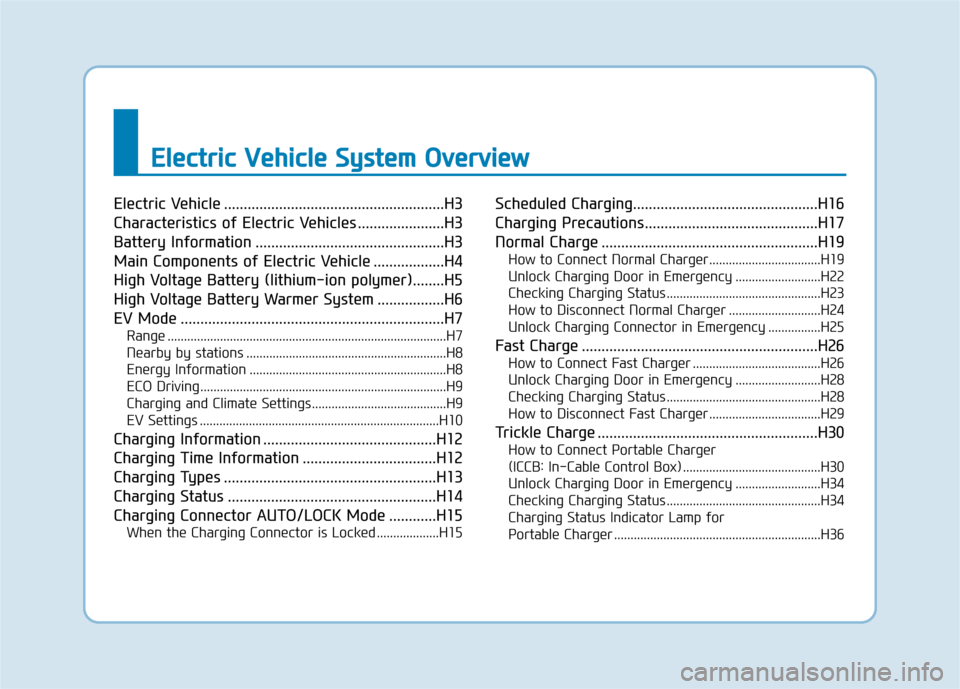
E
El
le
e c
ct
tr
r i
ic
c
V
V e
eh
h i
ic
c l
le
e
S
S y
ys
st
te
e m
m
O
O v
ve
e r
rv
v i
ie
e w
w
Electric Vehicle ........................................................H3
Characteristics of Electric Vehicles ......................H3
Battery Information ................................................H3
Main Components of Electric Vehicle ..................H4
High Voltage Battery (lithium-ion polymer)........H5
High Voltage Battery Warmer System .................H6
EV Mode ...................................................................H7
Range ........................................................................\
.............H7
Nearby by stations .............................................................H8
Energy Information ............................................................H8
ECO Driving ........................................................................\
...H9
Charging and Climate Settings.........................................H9
EV Settings ........................................................................\
.H10
Charging Information ............................................H12
Charging Time Information ..................................H12
Charging Types ......................................................H13
Charging Status .....................................................H14
Charging Connector AUTO/LOCK Mode ............H15
When the Charging Connector is Locked ...................H15
Scheduled Charging...............................................H16
Charging Precautions............................................H17
Normal Charge .......................................................H19
How to Connect Normal Charger..................................H19
Unlock Charging Door in Emergency ..........................H22
Checking Charging Status ...............................................H23
How to Disconnect Normal Charger ............................H24
Unlock Charging Connector in Emergency ................H25
Fast Charge ............................................................H26
How to Connect Fast Charger .......................................H26
Unlock Charging Door in Emergency ..........................H28
Checking Charging Status ...............................................H28
How to Disconnect Fast Charger ..................................H29
Trickle Charge ........................................................H30
How to Connect Portable Charger
(ICCB: In-Cable Control Box) ..........................................H30
Unlock Charging Door in Emergency ..........................H34
Checking Charging Status ...............................................H34
Charging Status Indicator Lamp for
Portable Charger ...............................................................H36
Page 484 of 541
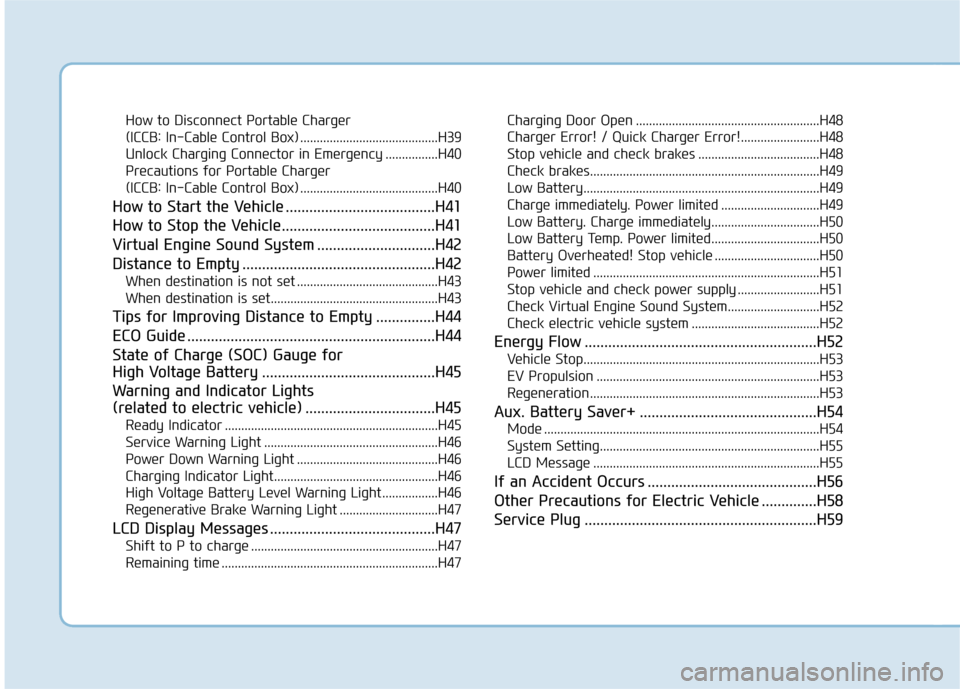
How to Disconnect Portable Charger
(ICCB: In-Cable Control Box) ..........................................H39
Unlock Charging Connector in Emergency ................H40
Precautions for Portable Charger
(ICCB: In-Cable Control Box) ..........................................H40
How to Start the Vehicle ......................................H41
How to Stop the Vehicle.......................................H41
Virtual Engine Sound System ..............................H42
Distance to Empty .................................................H42
When destination is not set ...........................................H43
When destination is set...................................................H43
Tips for Improving Distance to Empty ...............H44
ECO Guide ...............................................................H44
State of Charge (SOC) Gauge for
High Voltage Battery ............................................H45
Warning and Indicator Lights
(related to electric vehicle) .................................H45
Ready Indicator .................................................................H45
Service Warning Light .....................................................H46
Power Down Warning Light ...........................................H46
Charging Indicator Light..................................................H46
High Voltage Battery Level Warning Light .................H46
Regenerative Brake Warning Light ..............................H47
LCD Display Messages ..........................................H47
Shift to P to charge .........................................................H47
Remaining time ..................................................................H47 Charging Door Open ........................................................H48
Charger Error! / Quick Charger Error!........................H48
Stop vehicle and check brakes .....................................H48
Check brakes......................................................................H4\
9
Low Battery........................................................................\
H49
Charge immediately. Power limited ..............................H49
Low Battery. Charge immediately.................................H50
Low Battery Temp. Power limited.................................H50
Battery Overheated! Stop vehicle ................................H50
Power limited .....................................................................H51\
Stop vehicle and check power supply .........................H51
Check Virtual Engine Sound System............................H52
Check electric vehicle system .......................................H52
Energy Flow ...........................................................H52
Vehicle Stop........................................................................\
H53
EV Propulsion ....................................................................H53
Regeneration ......................................................................H5\
3
Aux. Battery Saver+ .............................................H54
Mode ........................................................................\
............H54
System Setting...................................................................H55
LCD Message .....................................................................H55\
If an Accident Occurs ...........................................H56
Other Precautions for Electric Vehicle ..............H58
Service Plug ...........................................................H59
Page 485 of 541

H3
Electric Vehicle
An electric vehicle is driven using a
battery and an electric motor. While
general vehicles use an internal
combustion engine and gasoline as
fuel, electric vehicles use electrical
energy that is charged inside the
high voltage battery. As a result,
electric vehicles are eco-friendly in
that they do not require fuel and do
not emit exhaust gases.
Characteristics of Electric
Vehicles
1. It is driven using the electricalenergy that is charged inside the
high voltage battery. This method
prevents air pollution since fuel,
like gasoline, is not required,
negating the emission of exhaust
gases.
2. A high performance motor is used in the vehicle as well. Compared
to standard, internal combustion
engine vehicles, engine noise and
vibrations are much more minimal
when driving.
3. When decelerating or driving downhill, regenerative braking is
utilized to charge the high voltage
battery. This minimizes energy
loss and increases the distance to
empty.
4. When the battery charge is not sufficient, normal charge, quick
charge and trickle charge are
available. (Refer to "Charge Types
for Electric Vehicle" for details.)
Information
What does regenerative braking do?
It uses the electric motor when decel-
erating or braking which transforms
vehicle motion (kinetic energy) to elec-
trical energy to charge the high volt-
age batteries. (Torque is applied in the
opposite direction when decelerating
to generate braking force and electric
energy.)
Battery Information
• The vehicle is composed of a highvoltage battery that drives the
motor and air-conditioner, and an
auxiliary battery (12 V) that drives
the lamps, wipers, and audio sys-
tem.
The auxiliary battery is automati- cally charged when the vehicle is in
the ready ( ) mode or the high
voltage battery is being charged.
i
E
EL
LE
E C
CT
T R
R I
IC
C
V
V E
EH
H I
IC
C L
LE
E
Page 489 of 541
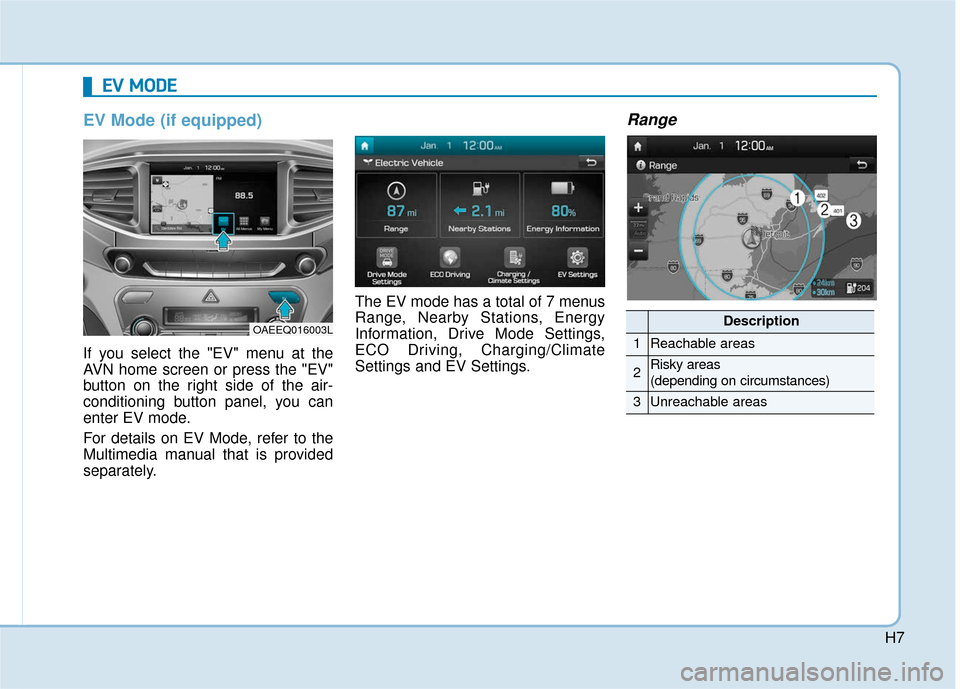
H7
EV Mode (if equipped)
If you select the "EV" menu at the
AVN home screen or press the "EV"
button on the right side of the air-
conditioning button panel, you can
enter EV mode.
For details on EV Mode, refer to the
Multimedia manual that is provided
separately.The EV mode has a total of 7 menus
Range, Nearby Stations, Energy
Information, Drive Mode Settings,
ECO Driving, Charging/Climate
Settings and EV Settings.
Range
E E
V
V
M
M O
OD
DE
E
OAEEQ016003LDescription
1Reachable areas
2Risky areas
(depending on circumstances)
3Unreachable areas
Page 524 of 541
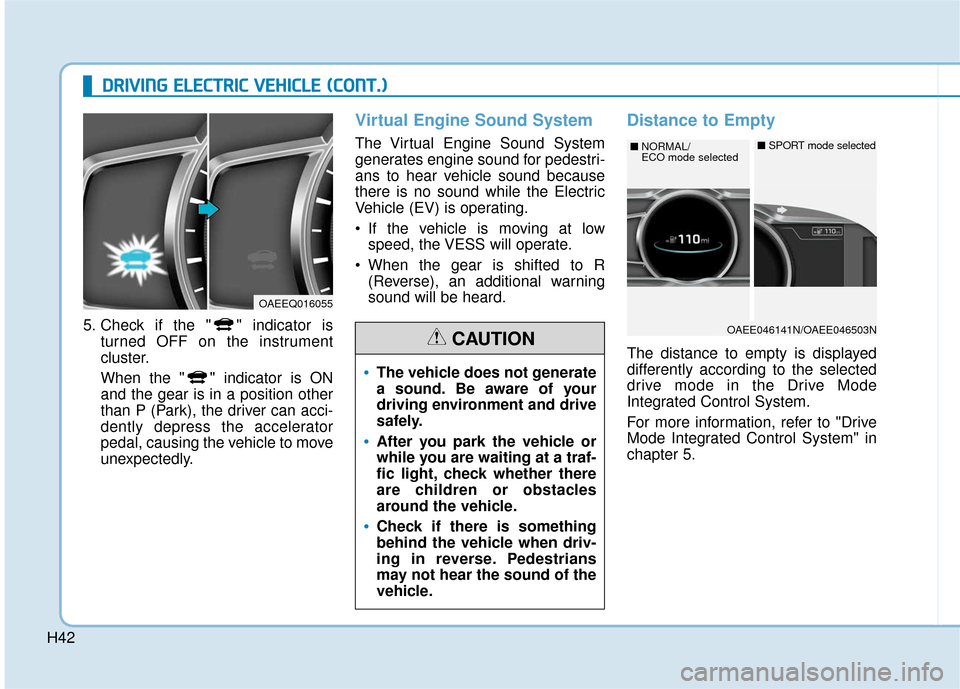
H42
D
DR
RI
IV
V I
IN
N G
G
E
E L
LE
E C
CT
T R
R I
IC
C
V
V E
EH
H I
IC
C L
LE
E
(
( C
C O
O N
NT
T.
.)
)
5. Check if the " " indicator is
turned OFF on the instrument
cluster.
When the " " indicator is ON
and the gear is in a position other
than P (Park), the driver can acci-
dently depress the accelerator
pedal, causing the vehicle to move
unexpectedly.
Virtual Engine Sound System
The Virtual Engine Sound System
generates engine sound for pedestri-
ans to hear vehicle sound because
there is no sound while the Electric
Vehicle (EV) is operating.
If the vehicle is moving at lowspeed, the VESS will operate.
When the gear is shifted to R (Reverse), an additional warning
sound will be heard.
Distance to Empty
The distance to empty is displayed
differently according to the selected
drive mode in the Drive Mode
Integrated Control System.
For more information, refer to "Drive
Mode Integrated Control System" in
chapter 5.
OAEEQ016055
The vehicle does not generate
a sound. Be aware of your
driving environment and drive
safely.
After you park the vehicle or
while you are waiting at a traf-
fic light, check whether there
are children or obstacles
around the vehicle.
Check if there is something
behind the vehicle when driv-
ing in reverse. Pedestrians
may not hear the sound of the
vehicle.
CAUTIONOAEE046141N/OAEE046503N
■ NORMAL/
ECO mode selected■SPORT mode selected
Page 525 of 541
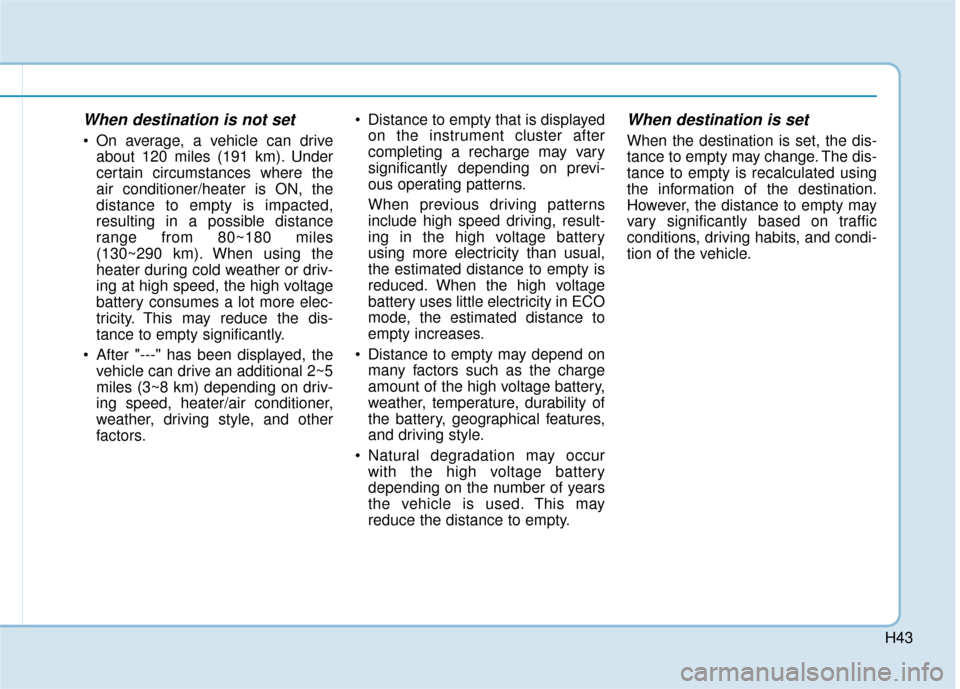
H43
When destination is not set
On average, a vehicle can driveabout 120 miles (191 km). Under
certain circumstances where the
air conditioner/heater is ON, the
distance to empty is impacted,
resulting in a possible distance
range from 80~180 miles
(130~290 km). When using the
heater during cold weather or driv-
ing at high speed, the high voltage
battery consumes a lot more elec-
tricity. This may reduce the dis-
tance to empty significantly.
After "---" has been displayed, the vehicle can drive an additional 2~5
miles (3~8 km) depending on driv-
ing speed, heater/air conditioner,
weather, driving style, and other
factors. Distance to empty that is displayed
on the instrument cluster after
completing a recharge may vary
significantly depending on previ-
ous operating patterns.
When previous driving patterns
include high speed driving, result-
ing in the high voltage battery
using more electricity than usual,
the estimated distance to empty is
reduced. When the high voltage
battery uses little electricity in ECO
mode, the estimated distance to
empty increases.
Distance to empty may depend on many factors such as the charge
amount of the high voltage battery,
weather, temperature, durability of
the battery, geographical features,
and driving style.
Natural degradation may occur with the high voltage battery
depending on the number of years
the vehicle is used. This may
reduce the distance to empty.
When destination is set
When the destination is set, the dis-
tance to empty may change. The dis-
tance to empty is recalculated using
the information of the destination.
However, the distance to empty may
vary significantly based on traffic
conditions, driving habits, and condi-
tion of the vehicle.
Page 540 of 541
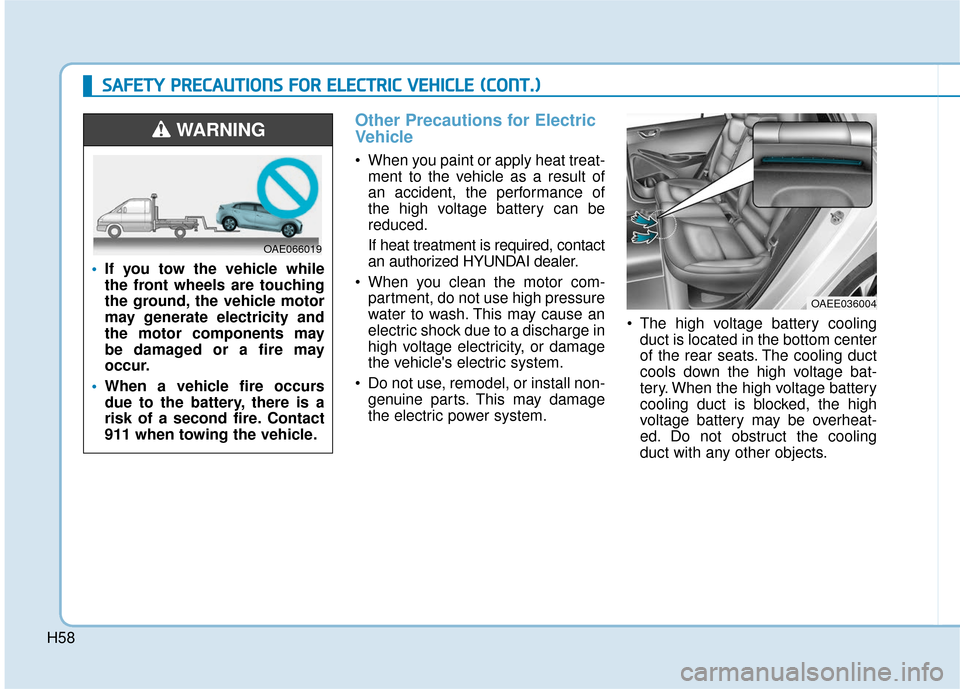
H58
Other Precautions for Electric
Vehicle
When you paint or apply heat treat-ment to the vehicle as a result of
an accident, the performance of
the high voltage battery can be
reduced.
If heat treatment is required, contact
an authorized HYUNDAI dealer.
When you clean the motor com- partment, do not use high pressure
water to wash. This may cause an
electric shock due to a discharge in
high voltage electricity, or damage
the vehicle's electric system.
Do not use, remodel, or install non- genuine parts. This may damage
the electric power system. The high voltage battery cooling
duct is located in the bottom center
of the rear seats. The cooling duct
cools down the high voltage bat-
tery. When the high voltage battery
cooling duct is blocked, the high
voltage battery may be overheat-
ed. Do not obstruct the cooling
duct with any other objects.
If you tow the vehicle while
the front wheels are touching
the ground, the vehicle motor
may generate electricity and
the motor components may
be damaged or a fire may
occur.
When a vehicle fire occurs
due to the battery, there is a
risk of a second fire. Contact
911 when towing the vehicle.
WARNING
OAE066019
OAEE036004
S
SA
A F
FE
E T
T Y
Y
P
P R
R E
EC
CA
A U
U T
TI
IO
O N
NS
S
F
F O
O R
R
E
E L
LE
E C
CT
T R
R I
IC
C
V
V E
EH
H I
IC
C L
LE
E
(
( C
C O
O N
NT
T.
.)
)